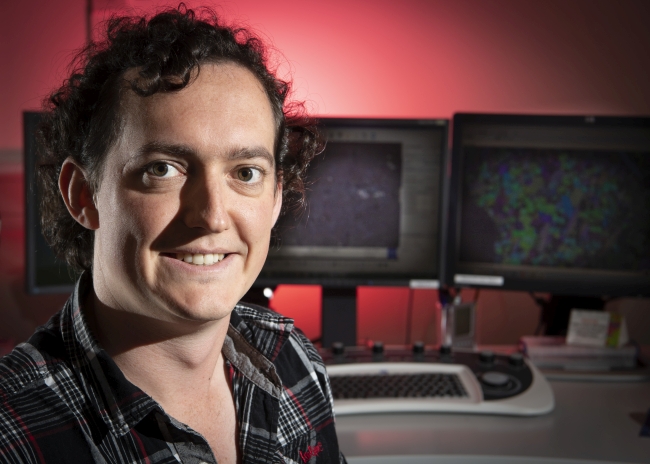New research uncovers ancient Martian meteorite’s shocking history
Published: 3 February 2022
Planetary scientists from the University of Glasgow have lent their support to an important new study of a Martian meteorite.
Planetary scientists from the University of Glasgow have lent their support to an important new study of a Martian meteorite.
The research, led by Curtin University in Australia, has found the first physical evidence of high-intensity damage caused by asteroid impact in ancient Martian meteorites, which could help identify when conditions suitable for life may have existed on early Mars.
Published in journal Science Advances, the research examined grains of the mineral zircon in Martian meteorite NWA 7034. The meteorite, colloquially known as ‘Black Beauty’, is a rare sample of the surface of Mars. The original 320-gram rock was found in northern Africa and first reported in 2013.
Lead author Morgan Cox, a PhD candidate from Curtin’s Space Science and Technology Centre (SSTC) in the School of Earth and Planetary Sciences, described the meteorite as a collection of broken rock fragments and minerals, mostly basalt, that solidified and became a rock over time. A zircon found inside the meteorite preserves evidence of damage that only occurs during large meteorite impacts.
Ms Cox said: “This grain is truly a one-off gift from the Red Planet. High-pressure shock deformation has not previously been found in any minerals from Black Beauty. This discovery of shock damage in a 4.45 billion-year-old Martian zircon provides new evidence of dynamic processes that affected the surface of early Mars.
“The type of shock damage in the Martian zircon involves ‘twinning’, and has been reported from all of the biggest impact sites on Earth, including the one in Mexico that killed off the dinosaurs, as well as the Moon, but not previously from Mars.”
Dr Luke Daly, of the University of Glasgow’s School of Geographical and Earth Sciences, is a co-author of the paper. Dr Daly has a longstanding relationship with researchers from Curtin, and was recently the lead author on a paper suggesting a new origin of some of the Earth’s water. That research used Curtin’s cutting-edge atom probe tomography technology to probe a dust sample from the asteroid Itokawa.
Dr Daly said: “One of the biggest unresolved questions about Mars is whether it ever had conditions which could have supported life, such as liquid water and a stable environment for any length of time. This habitable window is currently wedged between when Mars lost most of its atmosphere and its oceans about 3.7 billion years ago and when large asteroid impacts that could have sterilised the planet stopped, or at least became less frequent. We’re still piecing together the story of the major asteroid impacts on the red planet that may have affected early Mars’ potential habitability.
“Finding this ‘shock twin’ in Black Beauty for the first time is a remarkable discovery, which deepens our understanding of the impact history of Mars and helps us narrow down the window of time where the red planet may have been habitable. I’m delighted to have been part of the team which carried out this analysis.”
Co-author Dr Aaron Cavosie, also from Curtin’s SSTC, said the occurrence of zircon grains in the Black Beauty meteorite provided physical evidence of large impacts on early Mars, and had implications for the habitability of the young planet.
Dr Cavosie said: “Prior studies of zircon in Martian meteorites proposed that conditions suitable for life may have existed by 4.2 billion years ago based on the absence of definitive shock damage.
“Mars remained subject to impact bombardment after this time, on the scale known to cause mass extinctions on Earth. The zircon we describe provides evidence of such impacts, and highlights the possibility that the habitability window may have occurred later than previously thought, perhaps coinciding with evidence for liquid water on Mars by 3.9 to 3.7 billion years ago.”
The research team also included collaborators from the University of Western Australia.
The full research paper, ‘Impact and habitability scenarios for early Mars revisited based on a 4.45-Ga shocked zircon in regolith breccia’, is published in Science Advances.
First published: 3 February 2022
<< February

